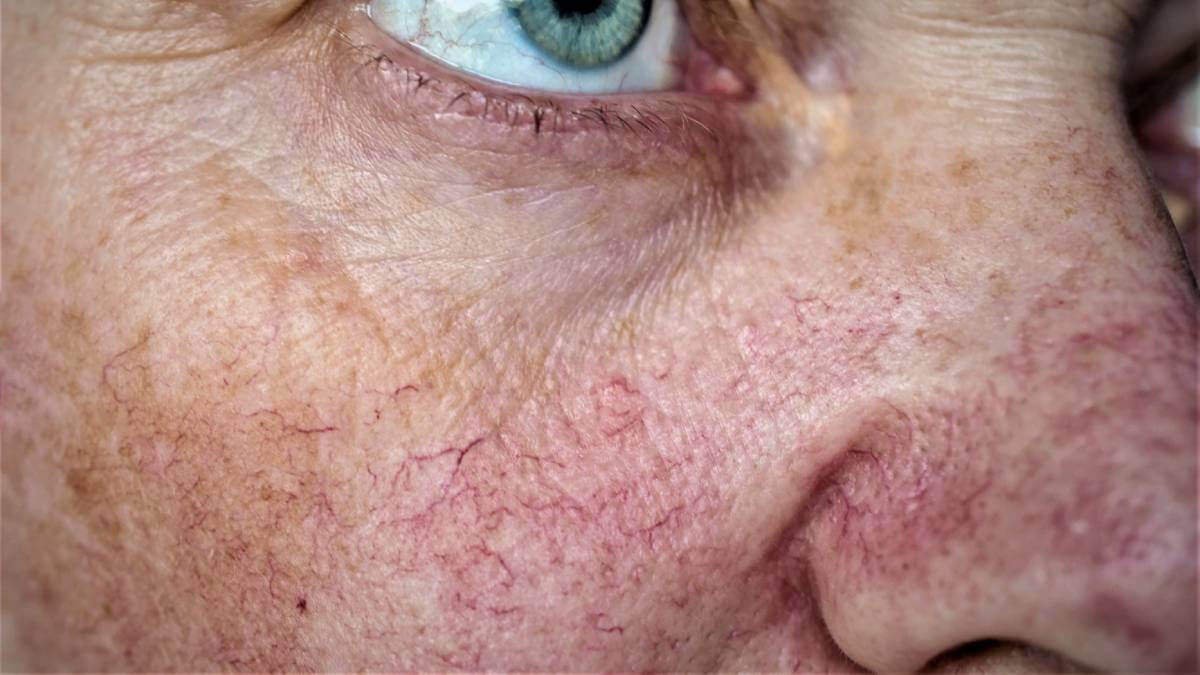Telangiectasias, informally known as spider veins, are little dilated blood vessels that form underneath the skin’s surface. They most commonly appear on the face but can pop up anywhere on the body and get their name from their web-like appearance. The veins are tiny, measuring only about one millimetre in diameter. Spider veins don’t cause any medical problems but they can be unsightly, and people often want them removed.
The nose and the chin are the most prominent regions on the face where spider veins form, with the primary cause being sun damage.
What causes spider veins?
Exposure to the sun damages the coating that surrounds all blood vessels, known as the internal elastic lamina. Which you can think of kind of like cling wrap. When the coating is destroyed, it causes blood vessels to expand and become visible just under the skin.
Other causes include:
- increased levels of the hormone oestrogen. So those who are pregnant or taking birth control or oestrogen replacement therapy are at higher risk
- ageing: as you age, your skin loses collagen which can make spider veins more apparent
- excessive sneezing or nasal congestion
- facial injuries and surgery that causes trauma to the skin
- hereditary or genetic reasons.
Prevention
Preventing spider veins can be difficult, especially if you’re at higher risk because of your genetics or the medication you take.
However, one of the best ways to prevent the formation of spider veins on the face is to consistently use sunscreen with an SPF of at least 30. Remember to reapply every two hours.
Maintaining an active and healthy lifestyle, incorporating exercises such as swimming or cycling along with a balanced diet, can also contribute greatly to overall vascular health.
Treatment
There’s no way to remove spider veins on your own. So if you don’t like how they look, see a dermatologist.
Various treatment options are available for addressing spider veins, with the most common one being laser treatment.
Laser treatment is the best way to get rid of spider veins, says Dr Mitchel Goldman, a dermatologist in San Diego who specialises in vein treatments. The heat from the laser destroys the blood vessel, causing it to shrink and eventually dissolve and be reabsorbed by the body.
One common form of laser treatment is using a pulsed dye laser. This uses intense, concentrated light beams to destroy the blood vessel without damaging the skin around it.
Intense pulsed light therapy can also get rid of spider veins, Dr Goldman adds, by using pulses of light to target blood vessels and boost collagen production. The treatment uses a broad spectrum of light, so it can also be used to treat other skin issues, such as acne scars, hyperpigmentation and wrinkles, at the same time.
Laser and intense pulsed light treatments may cause a little pain, Dr Goldman says. But they are safe and the side-effects, such as minor, temporary bruising, are minimal.
However, scarring or pigmentation changes are possible if the treatment isn’t performed correctly. It’s recommended to go to a board-certified dermatologist or other physician experienced in these procedures.
While spider veins typically disappear after treatment, they can reappear if you experience sun damage, take oestrogen or have facial trauma. In these cases, you may need to go for treatment once or twice a year.
Each of these treatment options aims to diminish the appearance of spider veins. Consulting a dermatologist is crucial to determine the most effective treatment plan.
Do you have spider veins? Would you like to have them removed? Why not share your thoughts in the comments section below?
Also read: When you should worry about varicose veins – and what to do about them
Disclaimer: This article contains general information about health issues and is not advice. For health advice, consult your medical practitioner.

